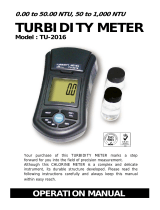
Micro 100 (5/10) Page 7
Rev. 3.3
2. The turbidity value displayed in the lower row of
the display should read 1000 NTU. This is the first
standard that must be used in calibration. Insert the
1000 NTU calibration standard into the sample well
(see figure 3) and index to the lowest value (see
section 5.1 if you have not already indexed the
standard) and wait for the reading to stabilize.
3. Press the enter key when the standard is in
position. After the enter key has been pressed, the
instrument will calibrate on the 1000 NTU level
(the “Store” block will flash) and the upper row of
the display should display 1000 NTU. The lower
row of the display now shows that the 10.0 NTU
calibration standard should be placed in the sample
well for continuing the calibration sequence.
4. Insert the indexed 10.0 NTU calibration standard
into the sample well and index to the lowest value
(see section 5.1 if you have not already indexed the
standard) and wait for the reading to stabilize.
5. Press the enter key when the standard is in
position. After the enter key has been pressed, the
instrument will calibrate on the 10.0 NTU level (the “Store” block will flash) and the upper row of
the display should display 10.0 NTU. The lower row of the display now shows that the 0.02 NTU
calibration standard should be placed in the sample well for continuing the calibration sequence and
wait for the reading to stabilize.
6. Insert the indexed 0.02 NTU calibration standard into the sample well and index to the lowest value
(see section 5.1 if you have not already indexed the standard).
7. Press the enter key when the standard is in position. After the enter key has been
pressed, the instrument will calibrate on the 0.02 NTU level. The instrument automatically exits
out of the calibration mode and then returns to the normal automatic mode. The display should read
0.02 NTU since this is the turbidity level of the standard that is still in the sample well. At this
point, you have calibrated the instrument so that it measures accurately across the full range of the
instrument.
8. Proceed to use the instrument normally.
NOTE: During calibration, the MICRO 100 will perform some system self-diagnostics. Several
error messages may be displayed. If there is an error, one of the four error messages E01, E02,
E03, and E04 will be displayed in the lower row of the display (see section 7.2).
NOTE: At any point in time during calibration, you can cycle through the required calibration
points (0.02 NTU, 10 NTU, and 1000 NTU) by pressing either the
or keys to
individually calibrate with a particular calibration standard. If you wish to exit the calibration
mode you may do so at any time by simply pressing the
key. However, exiting the
calibration process without completing the steps for calibration may cause the accuracy of the
instrument to be diminished.






















